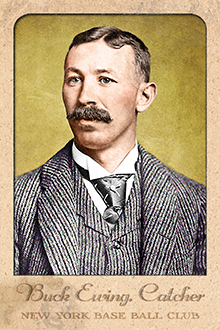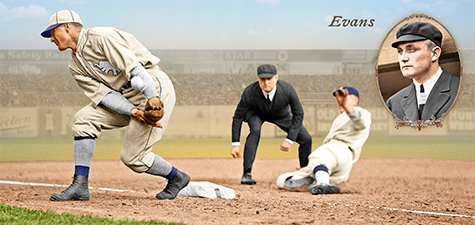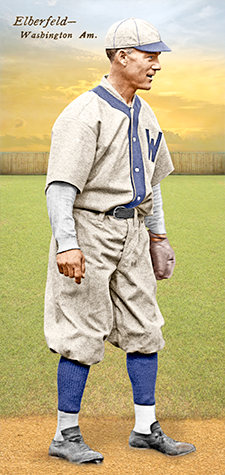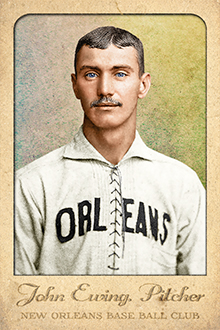- Series: Pilgrims
- City: Chicago
- Team: Cubs
- League: National League
- Hall: National Baseball Hall of Fame
John Joseph Evers (1881-1947) was immortalized as the pivot man with Joe Tinker and Frank Chance in the most famous double-play combo of all time. Evers was a good-hitting, slick-fielding 2nd baseman, winning World Series with the Cubs and Braves. A fiery-tempered man, Evers was said to have had more impact on a team than any at his position.
- The quintessential “small ball” player, Evers excelled in bunts, steals and heads-up play
- Saved a pennant race for Chicago by calling ump’s attention to Fred Merkle’s “Boner”
- Elected to Hall of Fame: 1946
Auction History
Cartophilia
T201 Mecca Canvas: Johnny Evers
- Series: Pilgrims
- League: American League
- Hall: National Baseball Hall of Fame
William George Evans (1884-1956) began as the youngest ML umpire and went on to a Hall of Fame career of whom a top Yankee pitcher said “He is the best, fairest and squarest umpire in the league.” A rare official with no playing experience, Evans quickly established his credibility in a rowdy era. In “one of the most disgraceful scenes ever witnessed on a ball field” his skull was fractured by a hurled bottle in a Browns/Tigers game.
- A gifted writer and analyst of the game, authored books and was an early sports columnist
- Went on to executive positions with teams and head of the minor league Southern Association
- Elected to Hall of Fame: 1973
Auction History
Cartophilia
T201 Mecca Canvas: Harry Gasper
- Series: Pilgrims
- City: Washington, D.C.
- Team: Senators
- League: American League
Norman Arthur Elberfeld (1875-1944), nicknamed the “Tabasco Kid” for his fiery temper and violent outbursts against umpires, covered 2nd base with a ferocity that daunted even Ty Cobb – who never slid head-first again after losing an encounter with Elberfeld’s spikes. Played mostly SS for 7 teams, 1898-1914 and was a solid hitter (.271 lifetime).
- Never afraid to take a spike, a punch or a pitch, he still ranks 13th on hit-batter list
- Career stats suffered from frequent suspensions and injuries
- Had a knack for mentoring young players, including rookie Casey Stengel
Auction History
Cartophilia
T201 Mecca Canvas: Kid Elberfeld
- Series: Pioneer Portraits II: 1875-1899
- City: New Orleans
- Team: Pelicans
- League: Southern League
John Ewing (1863-1895) had three early cups of coffee, playing 1 game in 1883 for the St Louis Browns, 1 game in ‘84 for the “Outlaw Reds” of the Union Association, and 1 game also in ’84 for the Washington Nationals of the UA. In that game, Long John had a triple and scored– the full extent of his offense until returning to MLB four years later. Ewing finally caught on as a pitcher in 1888 with the Louisville Colonels, playing there for 2 seasons before ending his career with the 1890 Giants of the Players’ League and their NL club in ’91 where he went out with a bang, earning the NL’s ERA title with 2.27. In all, Ewing played for six ML teams in four leagues during his brief career.
- Ewing’s brother Buck went on to a Hall of Fame career as infielder/manager
- The brothers were teammates for two seasons and John played under Buck as manager in ‘90

- Series: Pioneer Portraits II: 1875-1899
- City: New York
- Team: Giants
- League: National League
- Hall: National Baseball Hall of Fame
William Ewing (1859-1906) was the premier catcher of the 19th century, honored for decades after his early death as even, perhaps, the greatest player of all time. A scourge at bat, Buck hit over .300 ten times. He played behind the plate with courage and style, crouching close to the hitter so as to shave precious seconds off his inerrant throws. Ewing had debuted with the remarkable Troy Trojans in 1880 and joined four future Hall-of-Famers in moving to NYC in ‘83. The sturdy catcher may have been the primary inspiration for Jim Mutrie’s “my Giants!” exclamation that led to the new identity of the Gothams. An arm injury on a raw spring day curtailed his tenure behind the plate from 1891 on. Such a magnetic figure couldn’t escape the turmoil of the Players’ League controversies and Ewing was sometimes pilloried for lax effort. Despite such caviling, Ewing left as indelible a mark on the game’s first century as anyone. Upon his induction to Cooperstown (among the first six of the “pre-modern” era), he was hailed by Connie Mack as the greatest catcher he had seen and he had seen most.
- “Buck” was a derivative of “Buckingham,” bestowed on the budding star by an admiring scribe who wanted to add gravitas to the youngster’s reputation
- Played all nine positions and managed 3 different teams over 7 seasons
- Was the first catcher elected to the Hall of Fame; and the second 19th century player elected (after Cap Anson)
- Elected to Hall of Fame: 1939




